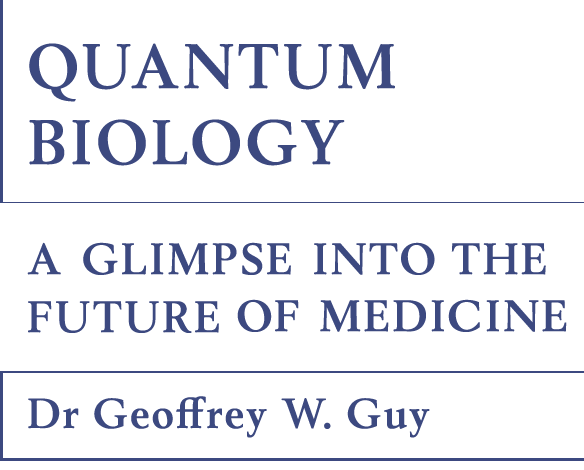
- About Geoffrey Guy
- List of chapters
- 1 Flatworms and xenobots
- 2 Beyond neurons: quantum effects in the brain
- 3 The ghost in the machine
- 4 Inflammation and equilibrium
- 5 The light fantastic
- 6 Lessons from the pandemic
- 7 Reassessing the causes of cancer
- 8 Energy, information and light
- 9 Before the origins of life
- 10 Unravelling the double helix
- 11 The computer in our cells
- 12 Space: the quantum frontier?
- 13 The quantum fractal
- 14 The path to mainstream
- Glossary
- Buy the book



3
The ghost in the machine
This page provides online resources relating to Chapter 3 of Quantum Biology: A Glimpse into the Future of Medicine. Read a chapter extract, or scroll down to access additional resources published by The Guy Foundation, and a list of further reading.
Name of the Chapter
Subheading
To a certain extent, the brain is an organ, and that organ must do something. But what if the brain is just the tube? What if the brain is the flux container that provides an environment in which quantum thought and quantum processes in terms of energy and information transition can take place? What if the brain we can see is purely a biological way of allowing those transitions to happen?
In other words, is biology itself a way of making the quantum processes of molecules portable? Life may have started in hot vents at the bottom of the ocean, but how did we move away from that? We need to package some of our energy and take it with us. If we’ve got a free supply of energy, we don’t need batteries, but if we want to run 100 metres, we have to find a way of storing and using it…
… Are the nerves and the neurons and the structures we see not in fact doing the thinking and the cerebration (that is, creating the consciousness), but rather do they only provide the environment in which that can go ahead?
Buy the book here.
2024 Autumn Series
Genes and metabolism: bioelectricity and the quantum spark of life
Find out more.
Videos

The Guy Foundation 2024 Autumn Series
The bioelectric field theory of consciousness
Professor Johnjoe McFadden, University of Surrey

The Guy Foundation 2021 Autumn Series
Radical pairs in xenon-induced anaesthesia and optical communication channels in the brain
Professor Christoph Simon, University of Calgary

The Guy Foundation 2021 Spring Series
Noninvasive sensory stimulation to induce gamma entrainment and neuroprotection
Dr Li-Huei Tsai, MIT
Betony Adams and Francesco Petruccione, ‘Do quantum effects play a role in consciousness?’, Physics World, 26 January 2021, physicsworld.com/a/do-quantum-effects-play-a-role-in-consciousness/
Jennifer C. Brookes, ‘Science is perception: what can our sense of smell tell us about ourselves and the world around us?’, Philosophical Transactions of the Royal Society A 368:1924 (2010), doi.org/10.1098/rsta.2010.0117
David J. Chalmers, ‘Facing up to the problem of consciousness’, Journal of Consciousness Studies 2:3 (1995), consc.net/papers/facing.pdf
Travis J. A. Craddock, Stuart R. Hameroff, Ahmed T. Ayoub, Mariusz Klobukowski and Jack A. Tuszynski, ‘Anesthetics act in quantum channels in brain microtubules to prevent consciousness’, Current Topics in Medicinal Chemistry 15:6 (2015), doi.org/10.2174/1568026615666150225104543
Travis J. A. Craddock, Philip Kurian, Jordane Preto et al., ‘Anesthetic alterations of collective terahertz oscillations in tubulin correlate with clinical potency: implications for anesthetic action and post-operative cognitive dysfunction’, Scientific Reports 7 (2017), doi.org/10.1038/s41598-017-09992-7
Stuart Hameroff, ‘Quantum computation in brain microtubules? The Penrose–Hameroff “Orch OR” model of consciousness’, Philosophical Transactions of the Royal Society A 356:1743 (1998), doi.org/10.1098/rsta.1998.0254
Stuart Hameroff and Roger Penrose, ‘Consciousness in the universe: a review of the “Orch OR” theory’, Physics of Life Reviews 11:1 (2014), doi.org/10.1016/j.plrev.2013.08.002
John Hewitt, ‘Electron spin changes as a general mechanism for general anesthesia?’, Phys.org, 11 August 2014, phys.org/news/2014-08-electron-mechanism-anesthesia.html
Christof Koch and Klaus Hepp, ‘Quantum mechanics in the brain’, Nature 440:611 (2006), doi.org/10.1038/440611a Christof Koch, Marcello Massimini, Melanie Boly and Giulio Tononi, ‘Neural correlates of consciousness: progress and problems’, Nature Reviews Neuroscience 17 (2016), doi.org/10.1038/nrn.2016.22
Christof Koch, ‘What is consciousness?’, Nature, 9 May 2018, nature.com/articles/d41586-018-05097-x
Na Li, Dongshi Lu, Lei Yang et al., ‘Nuclear spin attenuates the anesthetic potency of xenon isotopes in mice: implications for the mechanisms of anesthesia and consciousness’, Anesthesiology 129 (2018), doi.org/10.1097/ALN.0000000000002226
Jordan Smith, Hadi Zadeh-Haghighi, Dennis Salahub and Christoph Simon, ‘Radical pairs may play a role in xenoninduced general anesthesia’, Scientific Reports 11 (2021), doi.org/10.1038/s41598-021-85673-w
Luca Turin, Efthimios M. C. Skoulakis and Andrew P. Horsfield, ‘Electron spin changes during general anesthesia in Drosophila’, PNAS 111:34 (2014), doi.org/10.1073/pnas.1404387111
Roeland Van Wijk and Eduard P. A. Van Wijk, ‘An introduction to human biophoton emission’, Research in Complementary and Classical Natural Medicine 12:2 (2005), www.researchgate.net/publication/7795982_An_Introduction_to_Human_Biophoton_Emission
